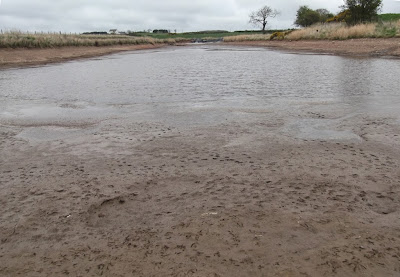A good weekend benefitted by the easterlies with rain which brought goodies for others on the east coast. At dusk on Saturday an influx of terns to Gosford Bay with a minimum of 164 Sandwich gathered on the shore at dusk, repeatedly flushing with a great clamour as the tide moved over the sand. Reminiscent of the 282 here on 28 April 2012, not sure if there are any higher spring counts, not since 1991 I think. 590+ BHG added to the noise, waders mainly Barwit.
Went back to check on same on Sunday, immediately spotted a tiny bird on the shore amongst the waders, almost wagtail like, and after a wait of 5 mins it flew to confirm my suspicions, the unique whirring jizz of a Little Tern. Watched it for half an hour as the tide flushed it every couple of minutes, unfortunately too small to pick out in any of my photos. From database seems this is fourth Little Tern record here since 1995, only other records were singles 20/7/05, 12/5/01 and 2E 29/4/01.
Meanwhile 10+ Sandwich were all that remained, 2 pairs stood beside each other mating in unison (!); these were also joined by an Arctic Tern. Waders included 99 Barwit and 56 Grey Plover, also a pair of Shelduck which tend to appear here in spring but I'm sure never breed right on the coast. Common Sandpiper and female Wheatear on the rocky shore.
Cycled to Blindwells in the afternoon and found Whitethroats back, 2 males singing against each other, along with Grasshopper Warbler, in areas south of west entrance. A House Martin amongst Swallows feeding over main pool. An interesting large falcon with jesses was circling over, my best guess was a Saker or hybrid, not an adult Peregrine. It was pursued by 2 Kestrels, also a third present and 2 Buzzards. A squealing Water Rail was a pleasing find at the artificial reedbeds - perhaps still a candidate for home list as a nocturnal migrant?
Dusk and back again to Gosford, only 114 Sandwich Terns gathered but visibility barely 200m with heavy drizzle, more could be heard beyond/fishing. Down at Seton just 270 Herrings and 10 LBB, no sign of the Iceland Gull reported from "Tranent" early evening, this c/o Ken. So I then headed off on a rare "twitch", got onto the Iceland just after sunset, still feeding in cereal south-west of Dolphingstone A1 junction with a few Herring Gulls. Grey-ish feathers on mantle suggested to me that it was a 2nd-win/sum, in which case I suspect it could be the Musselburgh bird, but have not seen any photos of the latter. Exceedinly poor photo below even by my standards, it was also raining by this stage!
Together with Barn Owl a good batch of year list additions so I totalled my patchworkchallenge list for the first time this year, comes to 107 with several bad omissions including Grey Partridge.
Better shots of Longniddry beach and Long Craigs rocks at Seton viewing towards Inchkeith from dusk on Saturday below.


























